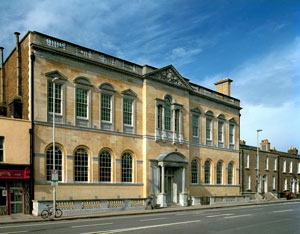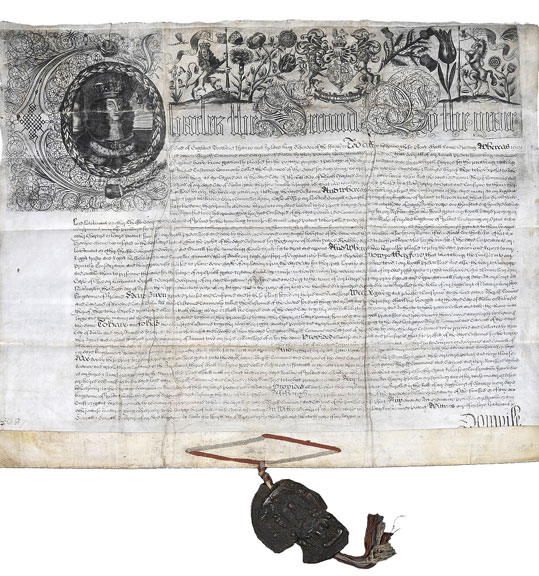By Linda Hickey

One of the most prized collections in Dublin City Archives is our collection of 102 royal charters. Issued by successive English monarchs and their representatives, these charters granted rights such as privileges and property, the right to run a ferry on the River Liffey, pardons to the people of Dublin for various offences, grants of land etc. Some were very precise, such as the charter that granted permission to the lord mayor and citizens of Dublin to levy tolls on each ‘crannoc of corn’ brought into the city until the following Christmas. Another granted permission to the lord mayor of Dublin (and his successors) to have a sword borne before him in procession, like the lord mayor of London. An interesting one that stood out for me was charter no. 33, issued by King Edward III in 1363, confirming the right of the citizens of Dublin not to have to bear office in foreign countries against their will.
The earliest charter that we hold was issued by King Henry II in 1171. Following the Norman invasion of Ireland, Dublin was seized by Strongbow in 1170. Alarmed by this, Henry decided to make a visit to Ireland. During his visit he resided in a tent, where he received the submission of Irish kings. His journey was financed by the merchants of Bristol. This resulted in the issuing of our first charter, which gave the men of Bristol the right to live in the city of Dublin (ad habitanda, ‘to live’). The text was written right through from left to right, leaving no room for additions. When asked what our earliest document is, we are very fortunate to be able to talk about this extremely significant item.

The charters in our collection range in date from 1171 to 1727. An examination of the series reveals clear changes in language and design. Each charter originally had the monarch’s seal, most of which have unfortunately been damaged or lost. The medieval charters were issued on plain parchment, occasionally with some ornamentation in the first line. From the early modern period (1540 onwards) it was customary to keep the first line blank, to leave space for decoration by an artist. Some later charters show intricate drawings of the monarch and symbols of the crown. The following three examples demonstrate the visual differences between some of our charters.
Charter no. 72, written in Latin on parchment, was issued by King Henry VIII on 4 January 1537/8. This granted a pardon to the lord mayor and commonalty of Dublin for all of their treasons and injuries to the Crown—no mean feat! It was issued as a reward for defence of the city against attacks by ‘Silken’ Thomas Fitzgerald and on the payment of a fine of twenty shillings into the hanaper (goblet). Since working with the charters I have noticed that there were quite a few pardons issued by monarchs over the years! In an earlier charter (no. 14), the lord mayor and citizens of Dublin were pardoned for having set fire to the western suburbs of the city in anticipation of the arrival of Edward and Robert Bruce in 1317.
The 82nd charter that we hold was issued by Queen Elizabeth I. This was a fee-farm grant to the City of Dublin of the former possessions of St Mary’s Abbey and the monastery of St Thomas the Martyr, written in Latin and on parchment. The seal has mostly survived and shows Queen Elizabeth I sitting on the throne.
Charter 98 was issued by King Charles II and attested by Arthur, Earl of Essex and lord lieutenant of Ireland. It showcases the use of the top paragraph for elaborate design. It is engraved with a portrait of the monarch, sitting inside his capital letter ‘C’, as well as the royal coat of arms, thistles and notably the Tudor rose. It was issued on 4 September 1676 and acted as a grant to the lord mayor, sheriffs, commons and citizens of Dublin of the customs of the gates. These were tolls to be levied on goods brought into the city.
The royal charters were initially held in the Dublin Tholsel, Skinners’ Row (opposite Christchurch Cathedral), until 1791. They were then transferred to the City Assembly House, South William Street, where they stayed until 1852, when they were moved again to Dublin City Hall, Cork Hill. In 1980 they came into the care and custody of Dublin City Archives. Initially they were held with the archive in the Dublin Civic Museum. Since 2003 they have been held in Dublin City Library and Archive, Pearse Street.
For preservation reasons we limit the amount of time that the charters are made available in person in our reading room. Thankfully, they have been scanned, so if anyone wants to get in touch to see a charter, please send us an email to cityarchives@dublincity.ie. The charters have also been listed and described in the Calendar of Ancient Records of Dublin, Vol. 1. This is available to view on the reference shelves in our reading room by appointment. We open Tuesday–Thursday 10.00am–16.30pm.
Linda Hickey is the Senior Archivist at Dublin City Library and Archive and is a member of the Local Government Archivists and Records Managers (LGARM).
